
Transcutaneous Electrical Nerve Stimulation (TENS) offers a natural or drug-free method of pain relief for people with acute or chronic pain. It uses a portable device called a medical TENS unit to deliver low-voltage electrical currents to interfere with the transmission of pain signals. This can help treat a wide variety of conditions, including arthritis, muscle soreness, injuries, and neuropathic pain. In addition, it promotes healing and muscle relaxation, improving the quality of life.
Many people experience varying levels of pain daily. This may range from mild discomfort to debilitating pain. Thus, effective pain relief is essential. While doctors typically prescribe pain medicines, it may come with unwanted side effects for some people. This has led to the rise of electrical stimulation devices like TENS. In this article, we will explore the benefits of TENS, how it works for pain relief, and the various conditions it can help treat.
Benefits of Using a Medical TENS Unit for Pain Relief
A medical TENS unit is a battery-operated device with a remote control and set of electrodes. The device has adjustable settings that users can program to suit their needs. This can provide numerous benefits to individuals dealing with pain. Firstly, it allows for personalised treatment. People can adjust the intensity and frequency of the electrical impulses to find the right balance of adequate stimulation of comfort.
Secondly, it is non-invasive and drug-free. One of the key benefits of TENS is that it has minimal risks. It does not involve needles or surgeries, making it a safe and convenient option for managing pain. Also, the natural approach minimises the risk of adverse side effects or dependency that are common with painkillers or long-term medication intake.
In addition to pain relief, a TENS unit can help improve circulation, reduce muscle tension, and enhance relaxation. In effect, it reduces inflammation that contributes to pain, thereby improving mobility and flexibility. Lastly, it promotes healing or speed up the recovery process of injuries.
Potential Side Effects
- Skin irritation, redness, or rash at the site of electrode pad placement.
- Muscle twitching or soreness due to the electrical stimulation.
- Muscle weakness or fatigue, especially when using the device for a prolonged time.
- Nausea or dizziness during or after use.
- Headaches or migraines triggered by the electrical pulses.
- Electrical burns if the intensity is turned up too high.
- Allergic reaction to the electrode gel or adhesive.
- Interference with implanted medical devices like pacemakers or defibrillators.
- An increase in pain or worsening of symptoms if used incorrectly.
- Discomfort when putting the electrodes on infected skin, broken skin, or open wounds.

Working Mechanisms of a Medical TENS Unit
A medical TENS unit works to relieve pain based on several mechanisms. Mainly, it delivers electrical impulses through the electrodes placed near the area of pain. These electrical signals travel along nerve fibres, essentially closing the passageway of pain signals in the spinal cord. As a result, it blocks the transmission of pain messages from reaching the brain.
Another mechanism is the stimulation of endorphin release. The electrical pulses induce the production of hormones like endorphins, which are the natural painkillers of the body. Endorphins bind to opioid receptors and inhibit them from releasing pain messages. Hence, it can provide further relief and comfort, especially for chronic pain conditions.
Moreover, the low soothing impulses from a TENS unit stimulate the blood vessels to dilate. This enables an increase in blood flow to the treatment area, reducing inflammation and relaxing the surrounding muscles. Likewise, it alleviates muscle tension or swelling, which contributes to pain. The improved circulation also helps in flushing out toxins and other waste materials.
Understanding the Role of Electrical Currents from TENS
The electrical currents from a TENS machine play an essential role in providing pain relief to users. These currents target nerve fibres and muscle tissues that stimulate the nervous system. It is similar to the natural electrical signals that flow within the body but at a higher frequency and intensity.
The stimulation of nerve fibres activates the natural pain-relieving mechanisms of the body, such as pain gate control and endorphin release. Furthermore, different types of electrical stimulation deliver various effects. For example, a continuous high-frequency current can help with acute pain, while a low-frequency current is more suitable for chronic pain management.

Different Types of Pain Treatable with a Medical TENS Unit
A medical TENS unit is known as a versatile device due to its capability to treat a wide range of pain conditions. These can be either acute (short-term) or chronic (long-term). One common type is neuropathic pain. This condition is a dysfunction or damage to the nerves, producing recurring or radiating symptoms. Sciatica and diabetic neuropathy are common examples.
Musculoskeletal pain, such as chronic back pain, arthritis, or fibromyalgia, is another treatable condition with a TENS unit. Placing the electrodes on either side of the spine can help alleviate discomfort in the area and improve mobility. Other joint pains like knee or shoulder pain can also benefit from TENS therapy.
A TENS machine can help relieve painful cramping during menstrual periods. Likewise, it offers women safe and drug-free pain relief during labour. People can also use it for everyday pains like muscle soreness due to work or physical activities. In addition, sports injuries like sprains and strains can help reduce discomfort and promote faster recovery. Lastly, TENS can be an adjunctive treatment for postoperative pain and rehabilitation.
When to See a Medical Professional?
There are several circumstances where it is crucial to consult a medical professional. Before starting TENS therapy, check if it is a suitable treatment. This is particularly important for people with heart problems, epilepsy, implanted devices, or who are pregnant.
Individuals should also seek medical attention if the pain does not go away or worsens despite TENS therapy. This could be an indication of an underlying medical condition that needs further evaluation and treatment. Additionally, if there are any unexpected side effects or skin irritation from using a TENS unit that causes further pain, it is advisable to consult a healthcare professional.
Conclusion
A medical TENS unit is a valuable tool that can provide symptomatic relief for a wide variety of pain conditions. It sends electrical impulses through electrodes on the skin to stimulate nerves and tissues. As a result, it activates natural pain-relieving mechanisms, such as pain gate control and endorphin release. This method can be a suitable natural alternative, especially for people who want to reduce or avoid the intake of medication.
TENS therapy offers comprehensive pain management. It can help treat muscle pain, nerve pain, joint pain or more. However, it is always important to consult a health professional to ensure safe and optimal results. Also, knowing when to seek medical help is crucial to prevent the pain or condition from worsening and to receive proper advice. Overall, people can manage chronic or acute pain in their homes and minimise the need to go to a pain clinic.




















